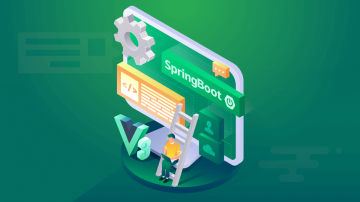SpringBoot3学习涵盖了Spring Boot3的简介、优点和应用场景,提供了详细的安装与环境搭建指南,并通过实战项目开发和常见问题解决,帮助开发者快速掌握Spring Boot3的核心概念和实际应用。
引入SpringBoot3 SpringBoot3简介Spring Boot是由Pivotal团队提供的全新框架,其主要目标是简化Spring应用的初始搭建以及开发过程。Spring Boot3是Spring Boot的最新版本,它基于Spring 5.3、Spring Security 5.7和Spring Boot 2.7进行构建,引入了大量的新特性和改进。Spring Boot3不仅仅简化了Spring应用的配置,还提供了大量的自动配置解决方案,使得开发者能够快速构建独立的、生产级别的应用。
Spring Boot3的核心理念是关注点分离,即开发者关注业务逻辑,而框架层面关注所有非业务逻辑的配置和实现。
SpringBoot3的优点和应用场景优点
- 开箱即用:Spring Boot提供了大量的默认配置,使得开发人员可以忽略很多配置细节,专注于业务逻辑的实现。
- 自动配置:Spring Boot会根据你的配置自动配置应用,比如数据库、缓存、CORS、静态内容等。
- 嵌入式服务器:Spring Boot内置了Tomcat、Jetty、Undertow作为应用服务器,简化了应用部署过程。
- 生产就绪特性:内置了健康检查、监控、外部化配置等功能,可以轻松进行应用监控和管理。
应用场景
- 微服务开发:Spring Boot非常适合开发微服务应用,可以轻松地集成Spring Cloud服务发现、服务调用等特性。
- RESTful API开发:Spring Boot支持开发高性能的RESTful API,提供了丰富的注解使得控制器的编写更加简洁。
- 企业级应用:Spring Boot可以构建复杂的企业级应用,支持事务处理、安全、AOP等特性。
- Web应用开发:Spring Boot内置了各种视图解析器和模板引擎,可以轻松构建动态Web应用。
示例代码
下面是一个简单的Spring Boot3项目的基本结构:
package com.example.demo;
import org.springframework.boot.SpringApplication;
import org.springframework.boot.autoconfigure.SpringBootApplication;
@SpringBootApplication
public class DemoApplication {
public static void main(String[] args) {
SpringApplication.run(DemoApplication.class, args);
}
}Java环境配置
要使用Spring Boot3,首先需要配置Java环境。Spring Boot3推荐使用Java 17或更高版本。
Windows环境配置
- 下载并安装Java:访问Oracle官网下载相应的Java发行版,如Java 17。
- 设置环境变量:
- 打开
控制面板 -> 系统和安全 -> 系统 -> 高级系统设置 -> 环境变量 - 在系统变量中添加
JAVA_HOME,值为Java的安装路径。 - 修改
Path变量,添加%JAVA_HOME%\bin。
- 打开
Linux环境配置
- 安装Java:使用
apt-get或yum命令安装Java,如sudo apt-get install openjdk-17-jdk。 - 设置环境变量:
- 修改
/etc/profile文件,添加以下内容:export JAVA_HOME=/usr/lib/jvm/java-17-openjdk-amd64 export PATH=$JAVA_HOME/bin:$PATH - 使用
source /etc/profile命令使配置生效。
- 修改
开发工具选择与配置
Spring Boot项目开发推荐使用IntelliJ IDEA或Eclipse等IDE。
IntelliJ IDEA
- 安装IntelliJ IDEA:访问JetBrains官网下载并安装IntelliJ IDEA。
- 创建新项目:
- 打开IntelliJ IDEA,选择
File -> New -> Project。 - 选择Spring Initializr,填写项目名,选择Java版本为17或更高。
- 打开IntelliJ IDEA,选择
- 导入依赖:
- 在
pom.xml文件中手动添加依赖,或者使用Spring Initializr向导添加。
- 在
Eclipse
- 安装Eclipse:访问Eclipse官网下载并安装Eclipse。
- 创建新项目:
- 打开Eclipse,选择
File -> New -> Spring Starter Project。 - 选择Java版本为17或更高。
- 打开Eclipse,选择
- 导入依赖:
- 在
pom.xml文件中手动添加依赖,或者使用Maven依赖管理器。
- 在
SpringBoot3项目初始化
使用Spring Initializr
- 访问Spring Initializr官网:https://start.spring.io/
- 选择项目设置:
- Project: Maven Project
- Language: Java
- Spring Boot: 3.0.0版本
- Java版本: 17
- Project Metadata:
- Group: com.example
- Artifact: demo
- Name: demo
- Description: A Spring Boot 3 application
- Packaging: Jar
- Java Version: 17
- Dependencies:
- Spring Web: 用于开发Web应用
- Spring Data JPA: 用于数据库操作
- 点击Generate按钮,下载项目压缩包。生成的项目结构如下:
demo
│── src
│ ├── main
│ │ ├── java
│ │ │ └── com
│ │ │ └── example
│ │ │ └── demo
│ │ │ ├── DemoApplication.java
│ │ │ └── controller
│ │ │ └── HelloWorldController.java
│ │ └── resources
│ │ └── application.properties
│ └── test
│ └── java
│ └── com
│ └── example
│ └── demo
│ └── DemoApplicationTests.java
└── pom.xml使用IDE创建项目
-
使用IntelliJ IDEA创建项目:
- 打开IntelliJ IDEA,选择
File -> New -> Project。 - 选择Spring Initializr,填写项目名,选择Java版本为17或更高。
- 打开IntelliJ IDEA,选择
- 使用Eclipse创建项目:
- 打开Eclipse,选择
File -> New -> Spring Starter Project。 - 选择Java版本为17或更高。
- 打开Eclipse,选择
创建Hello World项目
创建一个简单的Spring Boot应用,实现一个返回"Hello World"的RESTful API。
创建项目结构
demo
│── src
│ ├── main
│ │ ├── java
│ │ │ └── com
│ │ │ └── example
│ │ │ └── demo
│ │ │ ├── DemoApplication.java
│ │ │ └── controller
│ │ │ └── HelloWorldController.java
│ │ └── resources
│ │ └── application.properties
│ └── test
│ └── java
│ └── com
│ └── example
│ └── demo
│ └── DemoApplicationTests.java
└── pom.xml编写代码
- 创建控制器:在
src/main/java/com/example/demo/controller目录下创建一个名为HelloWorldController.java的文件。
package com.example.demo.controller;
import org.springframework.web.bind.annotation.GetMapping;
import org.springframework.web.bind.annotation.RestController;
@RestController
public class HelloWorldController {
@GetMapping("/hello")
public String hello() {
return "Hello World!";
}
}- 启动应用类:修改
DemoApplication.java文件,启动应用。
package com.example.demo;
import org.springframework.boot.SpringApplication;
import org.springframework.boot.autoconfigure.SpringBootApplication;
@SpringBootApplication
public class DemoApplication {
public static void main(String[] args) {
SpringApplication.run(DemoApplication.class, args);
}
}运行并测试应用
- 运行应用:使用IDE运行
DemoApplication类,或者使用Maven命令启动应用。
mvn spring-boot:run- 测试API:在浏览器或Postman中访问
http://localhost:8080/hello,查看返回的"Hello World!"。
依赖注入与自动配置
Spring Boot的核心是依赖注入和自动配置。依赖注入(DI)允许将对象的依赖关系从代码中抽取出来,交给Spring容器管理。而自动配置则可以根据类路径中的类、jar包等信息,自动装配所需的bean和配置。
示例代码
定义一个简单的服务类:
package com.example.demo.service;
public class GreetingService {
public String greet() {
return "Hello, Spring Boot!";
}
}定义一个控制器注入该服务:
package com.example.demo.controller;
import com.example.demo.service.GreetingService;
import org.springframework.beans.factory.annotation.Autowired;
import org.springframework.web.bind.annotation.GetMapping;
import org.springframework.web.bind.annotation.RestController;
@RestController
public class GreetingController {
@Autowired
private GreetingService greetingService;
@GetMapping("/greet")
public String greet() {
return greetingService.greet();
}
}自定义配置与属性
Spring Boot允许配置自定义属性,这些属性通常存储在application.properties或application.yml文件中,并且可以通过@Value注解注入到Java类中。
示例代码
定义一个属性文件application.properties:
app.name=MySpringBootApp
app.version=1.0.0在Java类中使用@Value注解注入属性:
package com.example.demo;
import org.springframework.beans.factory.annotation.Value;
import org.springframework.boot.CommandLineRunner;
import org.springframework.boot.SpringApplication;
import org.springframework.boot.autoconfigure.SpringBootApplication;
@SpringBootApplication
public class DemoApplication implements CommandLineRunner {
@Value("${app.name}")
private String appName;
@Value("${app.version}")
private String appVersion;
public static void main(String[] args) {
SpringApplication.run(DemoApplication.class, args);
}
@Override
public void run(String... args) throws Exception {
System.out.println("Application name: " + appName);
System.out.println("Application version: " + appVersion);
}
}应用启动与生命周期
Spring Boot应用的启动过程主要分为以下几步:
- 初始化:启动器会初始化一些Spring容器的配置并加载配置文件。
- 配置环境:读取
application.properties或application.yml文件,解析并应用配置。 - 创建Spring容器:构建并初始化Spring容器,加载所有自动配置的bean。
- 启动应用:启动应用服务器,监听HTTP请求。
示例代码
定义一个简单的启动监听器:
package com.example.demo;
import org.springframework.boot.CommandLineRunner;
import org.springframework.boot.SpringApplication;
import org.springframework.boot.autoconfigure.SpringBootApplication;
@SpringBootApplication
public class DemoApplication implements CommandLineRunner {
public static void main(String[] args) {
SpringApplication.run(DemoApplication.class, args);
}
@Override
public void run(String... args) throws Exception {
System.out.println("Application started...");
}
}实战项目选题
选择一个实际应用项目,比如一个简单的博客系统,包含用户管理、文章发布、评论等功能。
功能模块拆分与实现
- 用户管理模块
- 用户注册、登录、注销
- 用户信息维护
用户注册代码示例
package com.example.demo.controller;
import com.example.demo.service.UserService;
import org.springframework.beans.factory.annotation.Autowired;
import org.springframework.web.bind.annotation.PostMapping;
import org.springframework.web.bind.annotation.RequestBody;
import org.springframework.web.bind.annotation.RestController;
@RestController
public class UserController {
@Autowired
private UserService userService;
@PostMapping("/register")
public String register(@RequestBody User user) {
return userService.register(user);
}
}- 文章发布模块
- 文章发布
- 文章分类
- 文章归档
文章发布代码示例
package com.example.demo.controller;
import com.example.demo.service.ArticleService;
import org.springframework.beans.factory.annotation.Autowired;
import org.springframework.web.bind.annotation.PostMapping;
import org.springframework.web.bind.annotation.RequestBody;
import org.springframework.web.bind.annotation.RestController;
@RestController
public class ArticleController {
@Autowired
private ArticleService articleService;
@PostMapping("/publish")
public String publish(@RequestBody Article article) {
return articleService.publish(article);
}
}- 评论模块
- 评论发表
- 评论回复
- 评论审核
评论发表代码示例
package com.example.demo.controller;
import com.example.demo.service.CommentService;
import org.springframework.beans.factory.annotation.Autowired;
import org.springframework.web.bind.annotation.PostMapping;
import org.springframework.web.bind.annotation.RequestBody;
import org.springframework.web.bind.annotation.RestController;
@RestController
public class CommentController {
@Autowired
private CommentService commentService;
@PostMapping("/comment")
public String comment(@RequestBody Comment comment) {
return commentService.postComment(comment);
}
}项目打包与部署
打包项目
使用Maven打包项目:
mvn clean package -DskipTests部署项目
将打包生成的jar文件上传到服务器,使用命令启动应用:
java -jar target/demo-0.0.1-SNAPSHOT.jar常见错误及解决方法
- 依赖冲突:在
pom.xml或build.gradle文件中添加依赖时,可能会出现版本冲突问题,可以通过mvn dependency:tree命令查看依赖树,找到冲突的依赖并进行调整。 - 启动失败:启动时出现各种异常,可以通过查看日志文件定位问题,常见的是配置文件错误、依赖加载失败等。
- 请求无法访问:确保应用服务器已经启动,并且端口没有被占用。
示例代码
解决依赖冲突的示例:
<dependencyManagement>
<dependencies>
<dependency>
<groupId>org.springframework.boot</groupId>
<artifactId>spring-boot-dependencies</artifactId>
<version>3.0.0</version>
<type>pom</type>
<scope>import</scope>
</dependency>
</dependencies>
</dependencyManagement>性能优化与调优技巧
-
配置文件优化:
- 使用
spring.profiles.active设置不同的环境配置。 - 设置合理的线程池和连接池配置。
- 使用
-
代码优化:
- 使用
@Cacheable注解缓存数据。 - 使用
@Async注解异步处理耗时任务。
- 使用
- 资源优化:
- 压缩静态资源文件。
- 使用CDN加速静态资源加载。
示例代码
使用@Cacheable注解:
import org.springframework.cache.annotation.Cacheable;
import org.springframework.web.bind.annotation.GetMapping;
import org.springframework.web.bind.annotation.RestController;
@RestController
public class DataController {
@Cacheable(value = "data", key = "#id")
@GetMapping("/data/{id}")
public String getDataById(@PathVariable String id) {
// 数据获取逻辑
return "Data for id: " + id;
}
}日志管理和监控
Spring Boot内置了多种日志管理器,可以通过配置文件设置日志级别和输出格式。
示例代码
配置日志输出:
# application.properties
logging.level.root=INFO
logging.level.com.example.demo=WARN
logging.file.name=application.log
logging.file.path=/var/log/使用Spring Boot Actuator进行监控:
- 添加依赖:
<dependency>
<groupId>org.springframework.boot</groupId>
<artifactId>spring-boot-starter-actuator</artifactId>
</dependency>- 访问
http://localhost:8080/actuator查看监控信息。

 随时随地看视频
随时随地看视频




